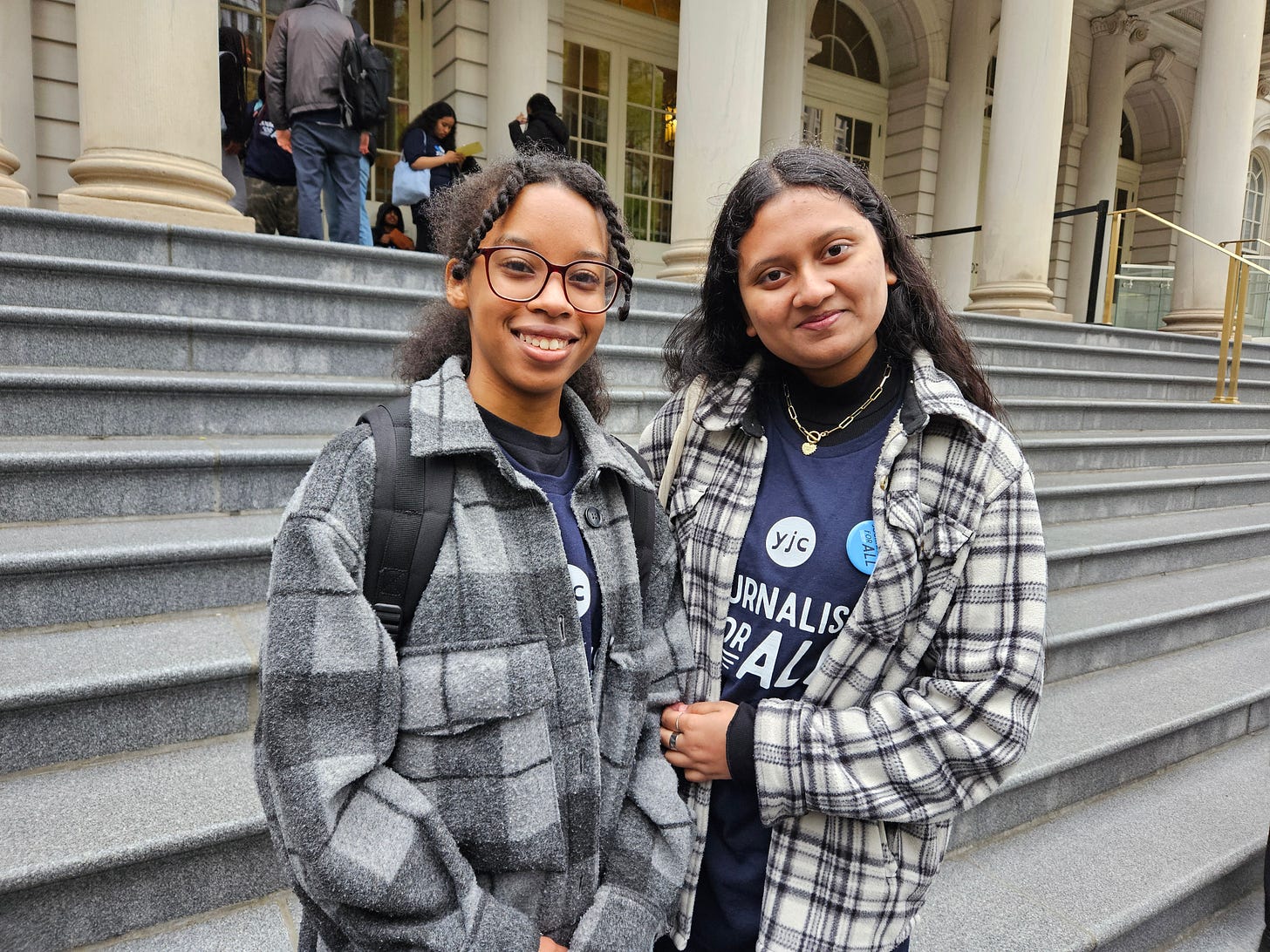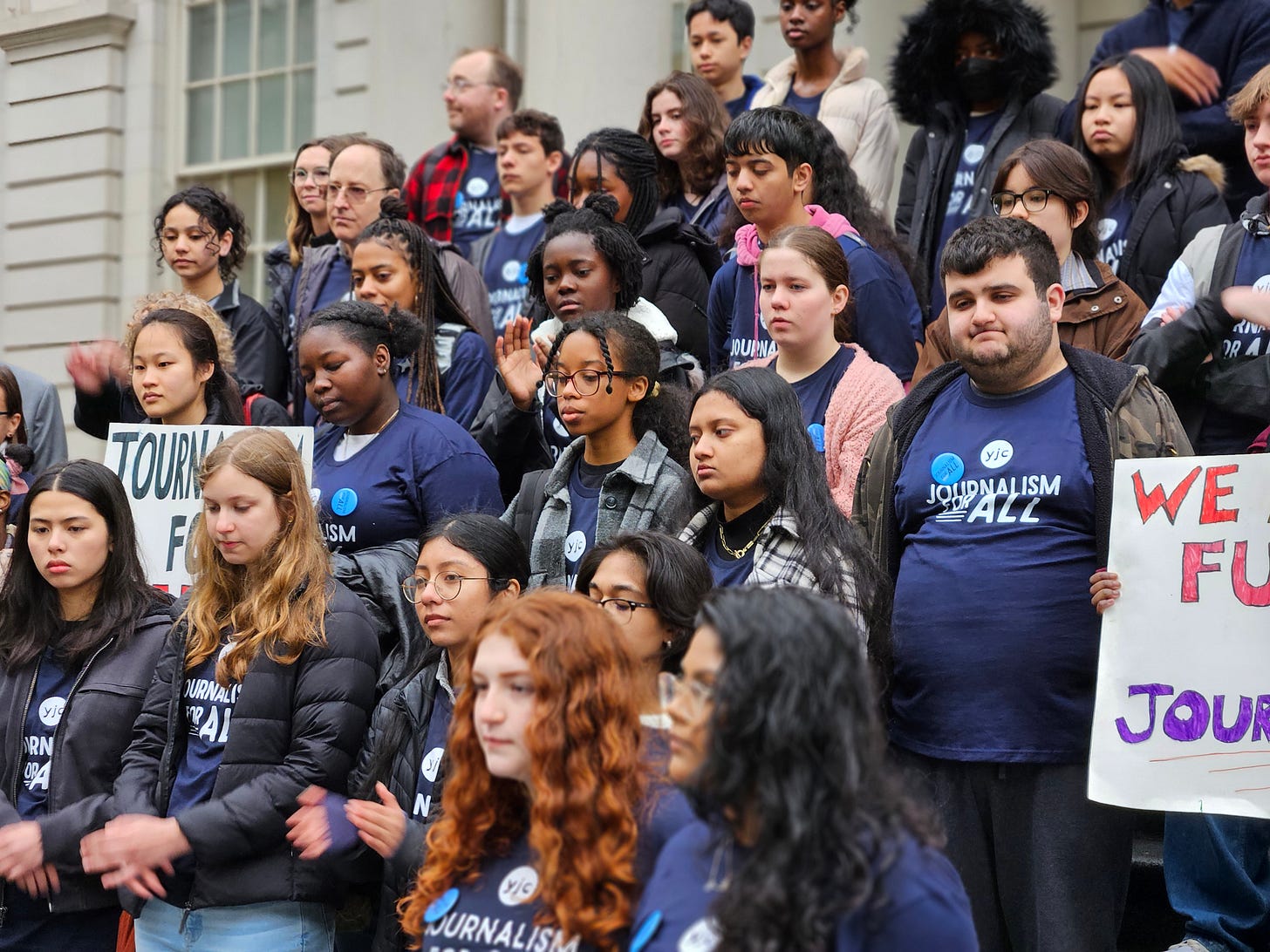NYC schools lack newspapers. That could soon change
Plus, how student journalism presents hyperlocal coverage opportunities

As a Black woman who feels the need to justify her existence in every room she walks into, Fredlove Deshommes found her place in journalism.
“I’ve been able to make my voice matter,” said the junior at Urban Assembly School for Law and Justice in Brooklyn.
However, her journalism experience has been limited to outside-of-school activities, mostly with the Youth Journalism Coalition and The Bell. She said she has never been to a school that has a newspaper or one that prioritizes media literacy.
Camila Sosa, a junior at Uncommon Collegiate Charter High School in Brooklyn, is in the same situation.
“It’s frustrating to me because it’s not my fault and it’s not the fault of other students that they’re not being able to experience these opportunities,” Sosa said.
They aren’t alone. About 73% of New York City public schools don’t have a student publication, according to 2022 data from Baruch College.
Here’s a further breakdown: Among 100 schools with the highest poverty rates, only 7% have a newspaper. In contrast, 62% of its lowest poverty rate counterparts do have one.
It’s a reality that prompted student journalists from across the city to rally in front of the City Hall last week to push for a new curriculum that will ensure access to journalism education.
No newspaper ≠ not trying
At Uncommon Collegiate Charter High School — a predominantly Black school — attempts to launch a newspaper have been hindered by a lack of administrative support, students said.
“I feel like they don’t value student journalism,” Sosa said. “Because it’s like they’re not taking us seriously. They’re putting up all these barriers and not making any solution for us.”
Nzingha Wright, also a junior at the school, expressed frustrations with the administration’s priorities for “academics.” She said if students aren’t in good standings, there’s no hope for extracurricular funding.
“Because of how we’re stereotyped, people don’t think that we are capable of knowing what’s happening outside of the world and how to articulate that,” Wright said.
Junior Apsara Saha echoed the sentiment. With a publication, she said she would cover social issues, her peers’ achievements and campus life.
The Nutgraf reached out to the school for comments over the weekend.


The initiative
The “Journalism For All” curriculum was developed by Craig Newmark Graduate School of Journalism at the City University of New York along with YJC partners such as Press Pass NYC, Chalkbeat and The Bell.
The program, set to launch in 2025, aims to recruit 30 high school students in its pilot cohort for a year-long elective focusing on news reporting, writing, editing and media ethics.
Its implementation seeks to institutionalize journalism education in public schools, bridging the gap between affluent and economically disadvantaged institutions.
The existence of journalism programs now largely depends on individual teacher interest and school administration support, said David Rohlfing, a newspaper advisor at Pace High School in Manhattan.
City officials have publicly supported the expansion push.
Providing hyperlocal coverage?
Student publications also have the opportunity to broaden their scope beyond campus borders, filling gaps in local media coverage.
New York’s media ecosystem largely focuses on topic-specific beats for the entire city rather than geographic ones for specific boroughs or neighborhoods, according to a 2020 study by Tow Center for Digital Journalism.
Looking at the gaps, Liza Greenberg, the managing editor of The Science Survey at the Bronx High School of Science, said students can provide localized coverage by drawing stories from their diverse communities.
“What they’re going to be writing about is going to be different from what other local news organizations are writing about,” she said.
Although high school papers mostly cover campus news, previous neighborhood reportings have showcased this potential. Here are some examples:
Manhattan: The Gallery at NYC Museum School in Chelsea covered a Starbucks union strike nearby. The Echo at High School for Math, Science and Engineering in Harlem ran a two-story series about the Second Avenue Subway project.
The Bronx: An investigation by The River News at Bronx River High School revealed a “dangerous” pattern of red-light violations near Lehman College.
Queens: The Bennett at Frank Sinatra School of the Arts in Astoria features a column highlighting small food businesses in the area as alternatives to large franchises.
Brooklyn: The Survey at Brooklyn Technical High School shed light on the Queenslink project’s potential benefits for area commuters. The Murrow Network at Edward R. Murrow High School reported on local flooding.
Staten Island: The Curtis Log at Curtis High School covered the exclusion of the Staten Island Pride Center from the local St. Patrick's Day parade.

Bigger picture
Media literacy education: It’s only required in California, New Jersey, Delaware and Texas.
Student press freedom: There’s a national push for legal protections for student journalists, with laws already enacted in 17 states.
Similar laws underway: Minnesota passed a bill for student journalists this month. New York advocates recently had a legal briefing with lawmakers. Model bills were introduced in Nebraska and Kentucky, among others.
Censorship: Despite students running their papers, censorship campaigns from teachers and administrators remain common.
Correction: David Rohlfing’s last name was spelled incorrectly in the earlier version.
Story Spotlight:
Student journalists still fighting for press freedom in Hawaii (Honolulu Civil Beat): Nearly two years after a law providing First Amendment protections for student journalists was enacted, the state Board of Education has yet to officially revise its policy regarding censorship in school-sponsored publications. This law is the fruit of more than six years of advocacy by students, teachers and the local journalism community.
Featured Opportunities:
NBC Universal is accepting applications for multiple roles for its Academic Year program. The deadline is April 26.
Poynter Institute is looking for an audience engagement fellow for MediaWise. This is a one-year, full-time position.
The Kansas City Star has multiple reporting internship openings.
The Student Press Law Center is accepting applications from high school students for its New Voices Student Leaders Institute 2024 until May 17.
The Associated Press Sports Editors are sponsoring four $1,000 scholarships for collegiate sports journalists. The deadline is May 24.
NYC high school students can apply for the CLARIFY News Reporting Internship with City Limits before May 24.
I want to hear from you: Why is student journalism important to you? What youth journalism initiatives are you advocating for? Is your student publication doing something cool that you’d like to share? Reach me at nutgrafnews@substack.com. I will respond! Also, please share.






